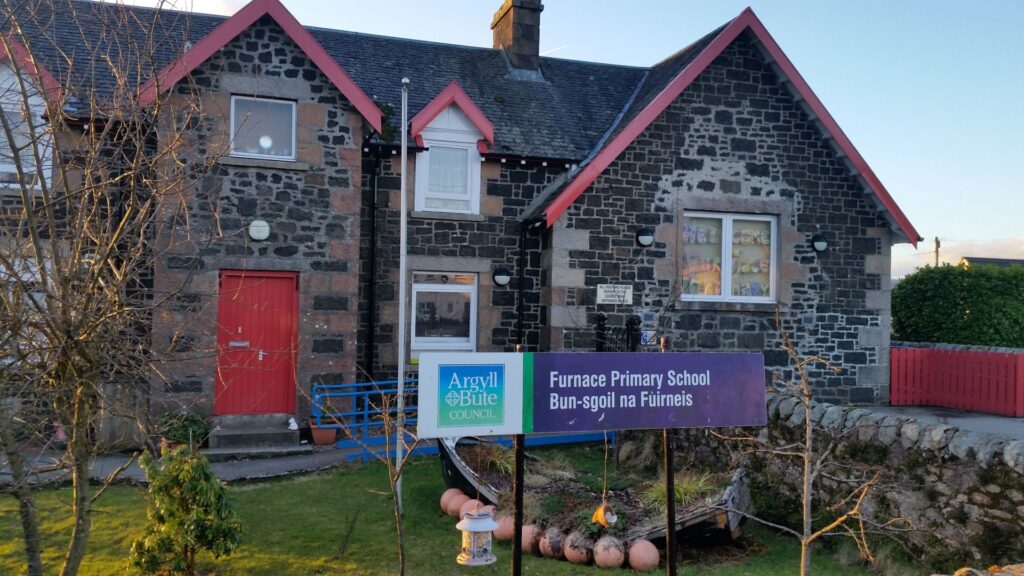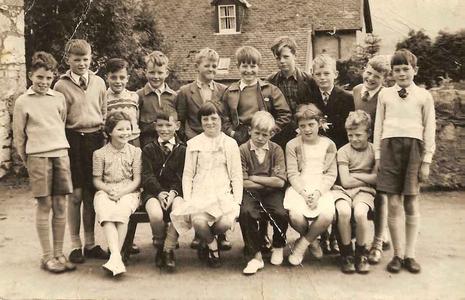
Furnace Primary School sits in the centre of the village. It has a small, but lively, population and is involved in many community events.

The school itself opened as Furnace Public School in 1876 with only 11 pupils, but in just 20 months the roll grew to 115! The staff consisted of one certificated teacher, one pupil teacher and a sewing mistress. In those days Furnace was a busy, industrial village with 2 mines nearby, an ironworks, a gunpowder factory and a weaving mill, with a much larger population than in modern times.
A Bit of History
The following has been provided by local historian, Duncan Beaton.
Before The Education (Scotland) Act of 1872 the schooling of our children was at the whim of local landed proprietors and the Established Church of Scotland. Because Inverleacain, later to become the village of Furnace, was on the boundary of two parishes, and relatively remote from the parish centres of Inveraray and Kilmichael-Glassary, it was down to the proprietors to make any rudimentary provision that was available prior to 1800.
The First Statistical Account for Inveraray & Glenaray Parish, written by the minister in the 1790s, says that there was a school “at the furnace”, and the 1818 estate map for Cumlodden, proprietor Crawford Tait of Harvieston, shows a school being provided for children on the Glassary side of the Leacain.
By the time of the Second Statistical Account in 1845 the Glenaray Parish school was at Craleckan, above the old road and near the big rock known as Clach a’ mhadadhain (Clach-a-vatan). This school was supported by the landowner, Argyll Estates, and the Duke was paying the teacher’s £8 per annum salary. Clach a’ mhadadhain school, as it was known, was a drystone building: when pointing out the site of this school, beside its old hawthorn tree, in the 1970s Willie Drew recalled knowing some of its last pupils. They were of course old men when he was a boy, but they told him of gathering moss to stop up the holes in the walls and keep out the drafts.
Attendance at these schools was erratic: children were removed to help with the seasonal work on the farms and, when of an age to do fulltime work, their schooldays were over. However, it appears that the school at Cumlodden had a large roll and a good success rate.
A school at Creggans was operated by Lady Victoria Campbell (1854-1910), a daughter of the 8th Duke of Argyll, who had contracted polio in her youth and never married. It had been opened by her father, and was classed as a Voluntary School, although by the time it opened there was a Board School in Furnace. The presence of Creggans School suited some people in Furnace, especially the outlying parts, who wanted to send their children “occasionally”. Registering at Creggans School meant they evaded the attentions of the Board School Attendance Officer, and were free to work on the seasonal harvests and so on. Andy Gardner recalled leaving Furnace School before Christmas to enrol at Creggans, where Lady Victoria always laid on a party for the children. Alexander Fraser, in his book “The Royal Burgh of Inveraray”, dated one such occurrence to 11th December 1896, but it probably happened every year until Creggans School closed in 1909: the children went back to Furnace Board School after the New Year holiday. One can only imagine what it was like for small children to walk along the shore road from Furnace to Creggans in the dead of winter. Of course, this did not stop in 1909. When Dougie Turner started at Furnace School in 1948 he was one of the small children who walked unaccompanied every day from Kenmore.
Despite the popularity of these schools, after the passing of The Education (Scotland) Act in 1872, the writing was literally on the wall. The new (present) Furnace Public School was opened on the 18th September 1876, and Cumlodden School eventually closed its door on the 22nd November 1878. The new Board Schools like Furnace were paid for by the local ratepayers and some additional government funding, and were governed by elected School Boards. The Boards, in turn, appointed Attendance Officers to ensure those enrolled actually attended: truancy was a serious matter.
“Truancy was a serious matter”
The access to free schooling, unencumbered by the needs of a proprietor who could demand tenants and their families to carry out free work on neighbouring farms at short notice, was seized upon. Martin Munro, who was brought up in Auchindrain, recalled his parents insisting he and his siblings attended and stuck in at their lessons. He also recalled his parents, prematurely aged and broken by the unremitting toil of subsistence farming. They did not want their children to live like that: all the children did well, and by the end of the 1930s the Munros had given up the tenancy in Auchindrain that they had held since coming from Killean in 1766.
Furnace Public School, as the primary school was originally known, taught children between the ages of five and fourteen, and in 1893 a wooden partition was constructed so that it could be pulled across to divide the room into a junior and senior section. This arrangement lasted until 1960, where years 1-3 were taught in the “wee end”, and 4-7 in the “big end”. In the early 1960s the school was considerably extended, and after almost seventy years this arrangement was no longer required.
Another major change had taken place in 1932, when pupils aged 12 and over were found places at Lochgilphead Higher Grade School. Some pupils refused to travel, but gradually this became the norm, and still is today.
Head Teacher: Lesley Goodwin
Furnace Primary School
Furnace By Inveraray
Argyll
PA32 8XU
Tel: 01499 500627
